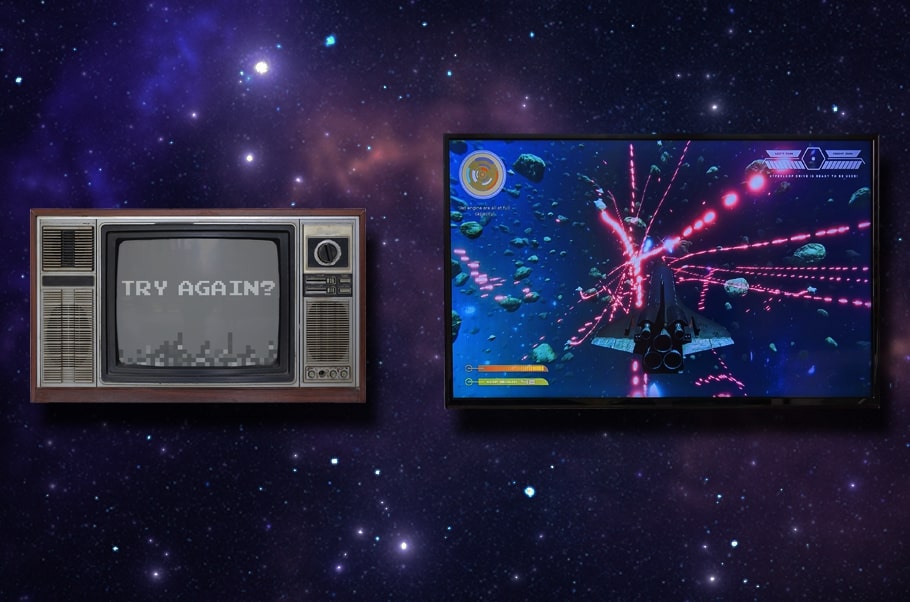A Brief History of Video Games
Decades of entertainment for millions of gamers.
To tell the origin story of video games, we must look at the early days of computers. In the 1950s, engineers began to use rudimentary machines to design simple games to play. A big breakthrough came in 1962 when MIT student Steve Russell, along with friends, created Spacewar! This title featured controllable spaceships that had to avoid a star’s “gravity” while also engaging in battle against one another.
Though having no real commercial success (its popularity was limited to the relatively small programming community of the era), Spacewar! was so impactful that it is now in the Library of Congress. In the following decade, more innovation took place, with a preponderance of hugely popular games (and their theme songs) like Pong, Space-Invaders and Pac-Man. But it wouldn’t stop there. In this posting, we’ll examine the origins of the video game industry and track its massive development. Today, it is a billion-dollar tech enterprise, providing unique experiences made even more immersive when enjoyed with gaming headsets like the Yamaha YH-G01.
THE GOLDEN 1970s
In 1972, North America was introduced to Pong. While today the title may seem overly simple, at the time it was mesmerizing. The game was essentially a digital version of table tennis, with a line down the middle and two digital “paddles” on either side of the screen that the player could move up and down. (Move it fast enough and you could even put a digital spin on the pixelated ball!) Like real ping-pong, the objective was to hit the ball back and forth until you could make your opponent (which could be another person or the computer) miss.
Six years later, the alien-fighting Space Invaders was released, followed in 1980 by Pac-Man. While these games were engaging and innovative, what made them supremely popular was the invention of the video arcade. The concept of the mechanized “penny arcade” had begun in the early 20th century. But the digital video game-based arcade began to pop up in the 1970s and was a magnet for young people.
Patrons would pump quarters into their favorite video games, which were housed in tall cabinets. As such, gaming was largely a public endeavor — kids would gather around and watch a friend try and beat a high score. At around the same time, the home gaming console was gaining ground in the market. By the mid-70s, Atari® was offering gamers the chance to play their favorite titles — like Pong — in the comfort of their living room.
But that was just the beginning.
THE UP-AND-DOWN 1980s
When the 1980s hit, video games were peaking in popularity. In fact, there was so much money and interest in video games that the market famously oversaturated and crashed in 1983. Some even pinpoint the fall to one specific title — one that’s considered by many to be the worst video game of all time: E.T. the Extra-Terrestrial. Its creation was rushed, pushed to release by Christmas the year of the famous Steven Spielberg film of the same name. There is even an urban legend that thousands of its unsold cartridges remain buried somewhere in New Mexico!
But with the (temporary) downfall of arcades and video games came the potential for a rebound. Enter Nintendo® with its Nintendo Entertainment System (NES) and its now-signature game, Super Mario Bros™, both of which were released in 1985. Gamers of today owe a great deal to the sibling Italian plumbers — Mario and Luigi — and their dedication to saving Princess Peach. NES games like Paperboy (1985), The Legend of Zelda™ (1986) and others sold like hotcakes.
COMPUTERS, CONSOLES AND THE 1990s
Nintendo released the first major handheld gaming system, Game Boy™, in 1990. Thanks to its success, the business of gaming grew immensely. Arcades were still relatively popular, but the focus was now more on home consoles and the burgeoning computer game market. With the advent of smaller yet ever more powerful “personal computers,” gamers at home were privy to titles with more advanced graphics like Wolfenstein 3D, a first-person point-of-view “shooter” game released in 1992 on CD-ROM.
Around this time, too, video game consoles rose in popularity. After NES, consoles like Sega Genesis and Super Nintendo found their ways into millions of homes, followed by the Nintendo 64 system, which featured the first-person shooter, GoldenEye 007 (1997). New video games with characters like Sonic the Hedgehog (1991) became household names. In addition, sports titles like Madden NFL ’94 (1993) and NBA Jam (1993) became prevalent. Not to be outdone, one-on-one fighting games like the bloody Mortal Kombat (1992) and Street Fighter II (1991) were fan favorites, played in arcades and at home.
BIGGER, BETTER 2000s
With the new millennium came new possibilities. In fact, the best-selling home console to date is Sony’s PlayStation 2®, which first hit the market in 2000. That console improved on the first PlayStation®, which debuted in the mid-90s and featured titles like the 3D flying game Star Fox (1993). In 2001, Microsoft made a power move and entered the fray with the Xbox™ console and its futuristic game, Halo: Combat Evolved (the first in the longstanding Halo franchise). From that point forward, the decade was dominated by bigger, better graphics each year and more in-depth titles featuring nuanced missions and heart-racing action.
THE GAMES OF TODAY
Today, gamers enjoy more options as ever before. There are handheld systems much more advanced than Game Boy, such as the Nintendo Switch™, which came out in 2017. There are also myriad titles of varying skill level available to gamers via their tablets and smartphones. Offerings like Angry Birds (2009) and Candy Crush Saga (2012) have generated millions of dollars and occupied almost as many hours of players’ free time.
Those who want more bang for their buck can dive into the über-realism of Second Life or the endlessly fascinating Minecraft™ series on their computers. Also available is the latest innovation from Sony: the company’s PS5 (PlayStation 5®). Even virtual reality gaming is growing, with titles like Beat Saber. Today, there are modern “open world” games that offer expansive, multi-faceted stages to navigate, and multiplayer games that give the chance for players to work in teams or compete against each another. Advanced titles like Red Dead Redemption II may even leave some speechless with their hyper-realistic details and advanced plots. No doubt about it: We’ve come a long way since Pong!















